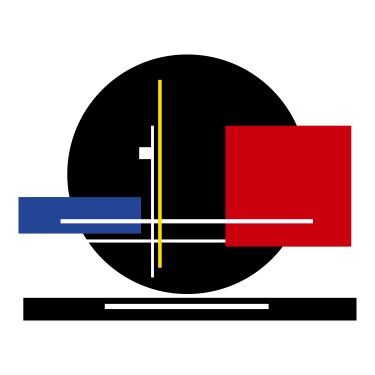 Jean (Albert) Gorin
Jean (Albert) Gorin
French (1899-1981)
Untitled constructivist composition
(4) Color serigraph
Signed and numbered 33/175 in pencil
Bears publisher’s blind stamp Denise Rene Editeur.
Acquired by Simpson/McCanse Fine Art – Tronto, Canada in 2012
Information on Gorin
Albert Jean Gorin was born at Saint-Emilien-de-Blain (Loire-Atlantique) December 2, 1899. From 1914-1916 he attended the Ecole des Beaux Arts at Nantes and then from 1919 to 1922, the Académie de la Grande Chaumiere in Paris. Initially influenced by Matisse, Van Gogh, Cezanne and the Expressionist movement he discovered Cubism in 1923 and was particularly impressed by Albert Gleizes’ book Du Cubisme (Paris 1921) After a period painting primarily in a pure Cubist vein, Gorin executed his first abstract painting in 1925 and in 1926 discovered the work of Piet Mondrian. Further development of the Cubist aesthetic resulted in an interest in furniture design and avant-garde architectural applications.
After a brief flirtation with Purism, he continued to move towards abstraction, especially after encountering Mondrian’s Neo-plasticism in 1926. Almost immediately, and permanently, he was converted to this aesthetic, creating works such as Composition No. 5 (1926; Paris, Pompidou). Gorin first exhibited his work in April 1928 at Lille with the group , alongside Mondrian and César Domela and others. In 1932 he travelled to the USSR and discovered Russian constructivism, another major influence in his work (especially Kasimir Malevitch), although Mondrian remained the prevailing one.
However, where Mondrian’s neoplasticism would only admit vertical and horizontal lines in its compositions, Gorin developed his own style by introducing the circle and then oblique lines whilst retaining the geometric rigour of pure neo-plasticism. He always worked with the same primary colours (bright red, light yellow and ultramarine blue) forming strong contrasts on white and black backgrounds.
His first exhibition took place in 1928 with the “S.T.U.C.A.” in Lille. There followed other associations and other exhibitions with groups such as “Cercle et Carré”, “L’Etrave”, “Renaissance Plastique” (which later became “Réalistés Nouvelles”).
In 1932 at the invitation of a leading group of intellectuals and artists, Gorin travelled to the Soviet Union and became influenced by the current Russian Constructivist movement and the work of Malevich in particular.
In 1934, he became a member of l’association Abstraction-Création. He moved to Vésinet in 1937, sold his house in Nort-sur-Erdre and destroyed a large part of his existing body of work. He was subject to the general mobilization in 1939 and became a prisoner of war in 1942.
After the war he settled in Grasse and owned a store selling objects d’art and decoration. Moving frequently in the ensuing years Gorin executed many sculptures that he then photographed and due to cramped living quarters would then destroy, the photographs being the only document of their existence.
In spite of his participation in numerous exhibitions, over many years the work of Gorin was not fully recognized until a significant retrospective was held at the Musée des Beaux-Arts at Nantes, in 1965, at the Stedelijk Museum of Amsterdam, in 1967, the National Center of Contemporary art in Paris, in 1969, and those of the museums of Grenoble and Saint Etienne, in 1973.
In 1977, the Musée des Beaux-Arts at Nantes organized the last major retrospective of Jean Gorin, during his lifetime.
Exhibitions
1928, Lille: œuvres néo-plastiques avec le groupe Stuca
1929-1930: Exposition avec le groupe Cercle et Carré créé par Michel Seuphor et Torrès-Garcia.
1930, Nantes: invité par le groupe artistique L’Etrave
1931, Paris: Exposition de son premier relief dans une exposition du groupe 1940
1945, Paris: Exposition Art concret, Galerie René Drouin.
1946: Salon des Réalités Nouvelles, dont il est le secrétaire
1948, New York: Exposition d’art abstrait constructif
1957, Paris: 50 ans de peinture abstraite organisée à la Galerie Creuze, première exposition particulière à la Galerie Colette Allendy
1958, Saint-Étienne: Les premières générations de l’art abstrait
1960, Liège: Musée de l’Art Wallon
1965, Nantes: Rétrospective (1921-1965) au Musée des Beaux-Arts
1966, Chicago: Exposition à la Kazimir Gallery
1967, Amsterdam: Rétrospective au Stedelijk Museum
1969, Paris: Rétrospective au Centre national d’art contemporain
1974, Paris: Exposition à la Galerie Denise René
1977, Nantes: Rétrospective au Musée des Beaux-Arts
1977, Paris: Centre Pompidou
1999, Blain: Hommage du mouvement Madi à Gorin, Château de la Groulais
1999, Grenoble: Exposition Jean Gorin